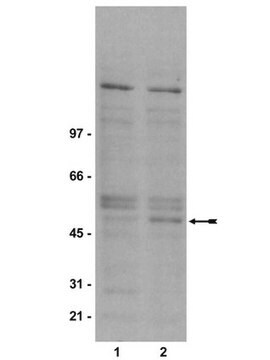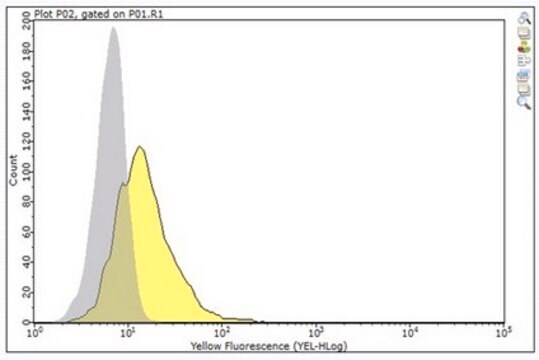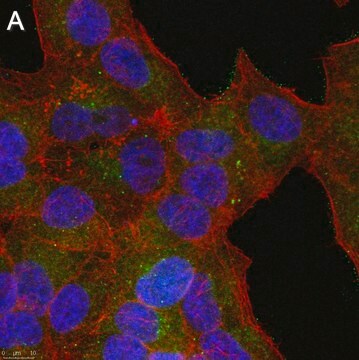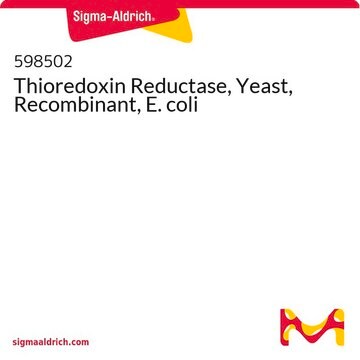05-413
Anti-phospho-GSK3 (Tyr279/Tyr216) Antibody, clone 5G-2F
clone 5G-2F, Upstate®, from mouse
Sinonimo/i:
GSK-3 alpha, glycogen synthase kinase 3 alpha
About This Item
Prodotti consigliati
Origine biologica
mouse
Livello qualitativo
Forma dell’anticorpo
purified immunoglobulin
Tipo di anticorpo
primary antibodies
Clone
5G-2F, monoclonal
Reattività contro le specie
mouse, human, rat
Produttore/marchio commerciale
Upstate®
tecniche
western blot: suitable
Isotipo
IgG1κ
Compatibilità
not suitable for immunoprecipitation
N° accesso NCBI
N° accesso UniProt
Condizioni di spedizione
dry ice
modifica post-traduzionali bersaglio
phosphorylation (pTyr279/pTyr216)
Informazioni sul gene
human ... GSK3A(2931)
mouse ... Gsk3A(606496)
rat ... Gsk3A(50686)
Descrizione generale
There exists two isoforms of GSK3, alpha and beta, and they show a high degree of amino acid homology. The two isoforms of GSK3 are strictly regulated via phosphorylation. Activation of GSK3 beta is dependent upon the phosphorylation of Tyr216 (Tyr279 in GSK3 alpha). Upon activation, it has been shown to phosphorylate a number of different cellular proteins, including p53, c-Myc, c-Jun, heat shock factor 1 (HSF1), and cyclin D1
Specificità
Immunogeno
Applicazioni
Signaling
PI3K, Akt, & mTOR Signaling
Qualità
Western Blot Analysis:
0.5-2 µg/mL of this lot detected phospho-GSK3 in RIPA lysates from human Jurkat cells. Previous lots detected phospho-GSK3 in mouse 3T3/A31, human A431 lysates and rat L6 cells
Descrizione del bersaglio
Stato fisico
Stoccaggio e stabilità
Handling Recommendations:
Upon receipt, and prior to removing the cap, centrifuge the vial and gently mix the solution. Aliquot into microcentrifuge tubes and store at -20ºC. Avoid repeated freeze/thaw cycles, which may damage IgG and affect product performance.
Risultati analitici
Positive Antigen Control: Catalog #12-303, Jurkat cell lysate.
Altre note
Note legali
Esclusione di responsabilità
Non trovi il prodotto giusto?
Prova il nostro Motore di ricerca dei prodotti.
Codice della classe di stoccaggio
12 - Non Combustible Liquids
Classe di pericolosità dell'acqua (WGK)
WGK 1
Punto d’infiammabilità (°F)
Not applicable
Punto d’infiammabilità (°C)
Not applicable
Certificati d'analisi (COA)
Cerca il Certificati d'analisi (COA) digitando il numero di lotto/batch corrispondente. I numeri di lotto o di batch sono stampati sull'etichetta dei prodotti dopo la parola ‘Lotto’ o ‘Batch’.
Possiedi già questo prodotto?
I documenti relativi ai prodotti acquistati recentemente sono disponibili nell’Archivio dei documenti.
Il team dei nostri ricercatori vanta grande esperienza in tutte le aree della ricerca quali Life Science, scienza dei materiali, sintesi chimica, cromatografia, discipline analitiche, ecc..
Contatta l'Assistenza Tecnica.








